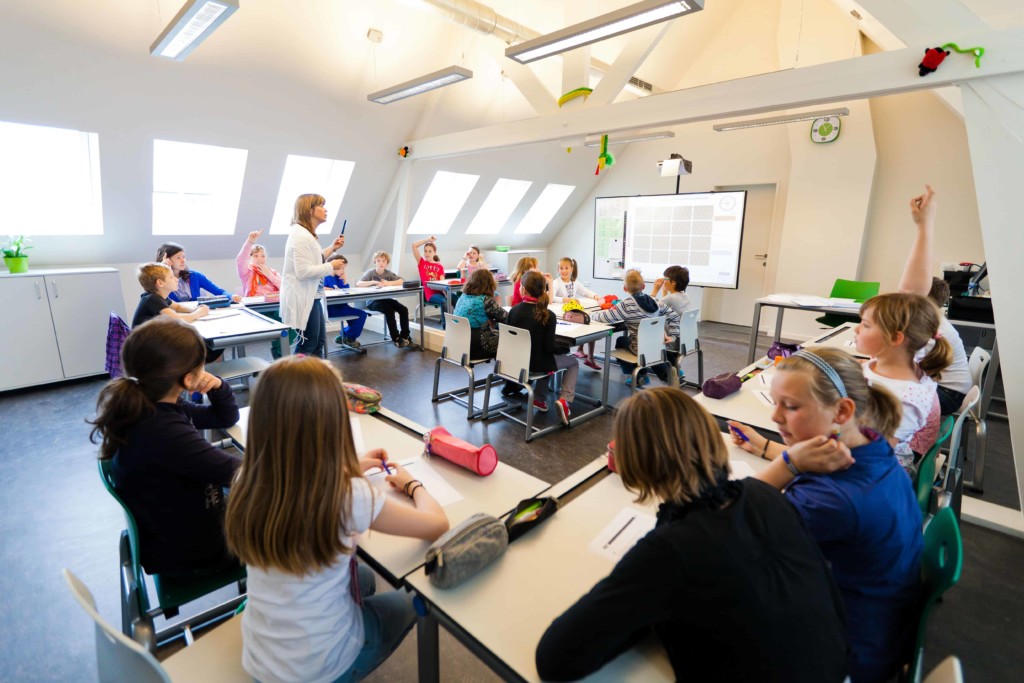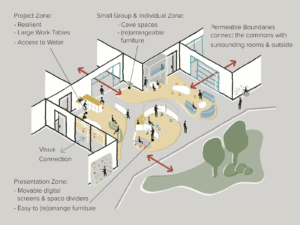4 Key Elements of 21st Century Classroom Design

By McKenna Wierman
Despite huge changes in lifestyle and technology, if you look at a classroom today and compare it to one in the early 20th century, you won’t notice many significant differences.
Sure, desks are more streamlined and there may be an interactive whiteboard or several computers in the room, but the basic setup is still the same—students sit in neatly aligned desks for the majority of the day while a teacher lectures at the front of the room. Fortunately, many professionals are trying to create classroom design for the 21st century in a manner that breaks out of the traditional mold. These classrooms aim to create an environment that foster students’ personal growth in communication, collaboration, creativity and leadership skills.
Wondering what this could look like? Here’s a peek at what 21st century classroom design will entail.
1. A Flexible Layout
Going hand-in-hand with the push for personalized learning, the driving concept behind 21st century classroom design is flexibility. Students’ days are full of choices that empower them to decide how they learn best, and they need an environment which supports that. An agile space also gives teachers the ability to respond to different students’ needs.
Typically, these classrooms include some version of a group gathering area, multiple seating options and a flex zone that can be adapted for unique learning activities. This layout allows for a variety of grouping formats and lesson types that take into account students’ widely varying learning styles. Twenty-first-century classrooms are driven by student’s interests, and the open, flexible spaces allow students to come together to share, collaborate and create.
2. Furniture for Utility
As already mentioned, to support flexibility schools are getting rid of standard desks and replacing them with a variety of different seating options. To allow for maximum utility of the space, portable furniture is a must in 21st century classroom design. Common examples of workstation options include yoga mats, exercise balls, kidney tables, standing tables, sofas and floor tables.
On average, children spend about ten hours of their day sitting, so classroom furniture should accommodate for their natural need to move. Giving students options that allow them to rock, bounce and rotate while they are sitting provides for enhanced circulation and concentration throughout the day—and all the learning benefits that come with. These classrooms also increase functionality for students by lowering whiteboards and making materials easily accessible.
3. Technology Integration
It’s no surprise that technology integration is a key aspect of modern classroom design. However, teachers and students are leveraging 21st century classroom design that utilizes these upgrades in new and different ways. These classrooms use technology as a tool to stimulate curiosity and inspire students’ desire to learn. Technology, whether it is laptops, tablets, or mobile devices, puts information at students’ fingertips and motivates them to research and make discoveries.
In addition, technology integration supports inclusive classrooms, as it allows students to move at their own pace whether they are looking for opportunities for enrichment or need help to catch up. Plus, learning at the right level and pace helps keep students engaged, which dramatically reduces inappropriate classroom behavior.
4. A Light-Filled Environment
Believe it or not, lighting is an important part of 21st-century classroom design. Bright fluorescent lighting is being replaced with more natural and incandescent light through the use of windows and lamps. Not only does this make students more comfortable and reduce headaches, but studies have shown that student learning rates have improved between 7 and 26 percent in classrooms that are exposed to adequate natural lighting. Flexible lighting options are also beneficial as students use technology more frequently since dimmed lights make screens easier to see.
Ready to start revamping your classroom for 21st century learning? Check out this cool Classroom Architect website to play with different designs and envision how you could put these ideas to use! Or, take a look at this Pinterest board for lots of great classroom organization and design tips!
This post originally ran on Edmentum.
For more, see:
- Three Ways to Design Better Classrooms and Learning Spaces
- Next Generation School Design
- Classroom Design and the Learning Experience
McKenna Wierman writes for Edmentum’s Segment Marketing team. Follow them on Twitter: @edmentum
Stay in-the-know with all things EdTech and innovations in learning by signing up to receive the weekly Smart Update.






Elaina D'Agostino
I liked the idea of a classroom using technology in order to inspire students to learn and fuel their curiosity. Though I do think that learning nowadays is heavily reliant on technology. If a school is going to design its classrooms, it might as well go for designs that incorporate technology and advancement into traditional learning. https://arkitex.com/projects/blinn-campus-renovations/